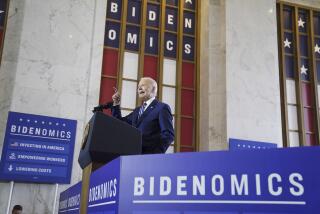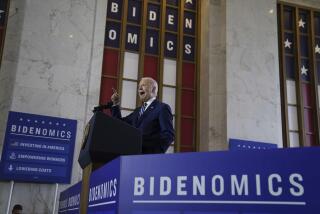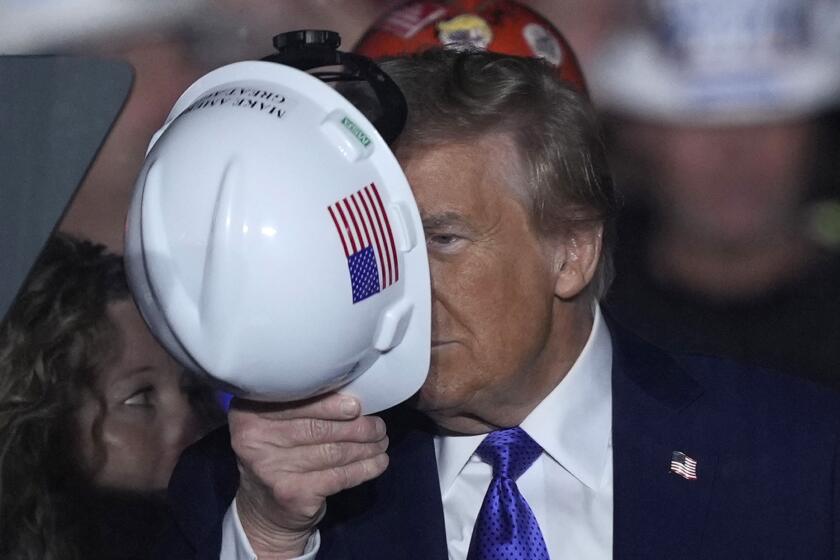Administration counters GOP criticism of stimulus
WASHINGTON — Responding to a string of Republican attacks against the $787-billion economic stimulus program, Obama administration officials launched a full-throated defense of the program Thursday, calling in reporters to argue that the surge in federal spending was blunting the recession and staving off even deeper job losses.
The worst economic crisis in more than half a century could not be reversed immediately, they said, adding that the stimulus program was designed as a two-year process rather than an instant injection of cash.
“The point of these programs on the jobs front is to cushion the blow -- to partially offset the deepest recession since the Great Depression,” said Jared Bernstein, Vice President Joe Biden’s top economic advisor.
Since March, the first full month of the stimulus operations, the unemployment rate nationwide has grown from 8.5% to 9.5%. Many economists predict that it will rise into double digits before the end of the year.
Administration aides said that the stimulus package had made the downturn “less worse,” although they conceded that that was hardly a phrase they could inscribe on billboards.
“You’ve never seen the president or vice president go out there and say, ‘We’re shooting for less worse, and damn it, we’re there,’ ” Bernstein said.
Yet, officials argued, there have been signs of progress. They released graphs showing that retail sales were stabilizing. After hitting $336 billion in December, retail sales in June stood at $342 billion, according to the administration.
Sales of new and existing homes also were starting to flatten out after years of decline, the White House said.
The briefing was a tacit admission that Republicans had succeeded in raising public concern about the stimulus program, especially its effect on the deficit. Through Web videos and news conferences, Republicans have cast the package as a wasteful program that is incurring dangerous levels of government debt.
Biden visited Richmond, Va., on Thursday to tout the stimulus program, venturing into the political base of House Republican whip Eric Cantor. Before Biden arrived, Cantor held a news conference and told reporters:
“It is common sense to measure success for the stimulus bill on the immediate impact it has on the economy -- not in how many websites may have been created or signs erected claiming credit.
“Since the stimulus bill passed and was signed into law, unemployment is up in Richmond, up in Virginia and up across this country,” he said.
Administration officials also were disputing the notion that stimulus spending was too slow. They released figures showing that commitments had been made to spend $183 billion in stimulus funds. An additional $43 billion has been in the form of tax breaks. The total amounts to $226 billion, or nearly 29% of the entire package.
Some of the $787 billion is intended for high-speed rail, broadband lines and an updated electrical grid -- projects that will take longer to complete, said Edward DeSeve, who is helping to oversee the stimulus program.
Robert Gibbs, the White House spokesman, said: “If what you wanted to do was just burp money into the economy, that’s what you do. But one of the main priorities of the recovery plan was not just to throw a bunch of cash out onto the street. I could do that from Marine One,” he said, referring to the presidential helicopter.
Some states already have made contractual commitments to spend billions in stimulus funds, the administration said.
Topping the list is California. A map put out by the administration showed that the state had made binding agreements to spend $16.5 billion in stimulus money, far more than any other state. The state with the second-highest level of spending commitments is New York, at $11.8 billion. Texas is third, at $9.5 billion; Florida fourth, at $7.4 billion.
--
More to Read
Get the L.A. Times Politics newsletter
Deeply reported insights into legislation, politics and policy from Sacramento, Washington and beyond. In your inbox three times per week.
You may occasionally receive promotional content from the Los Angeles Times.










